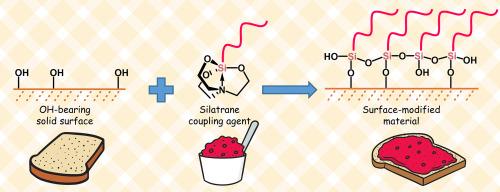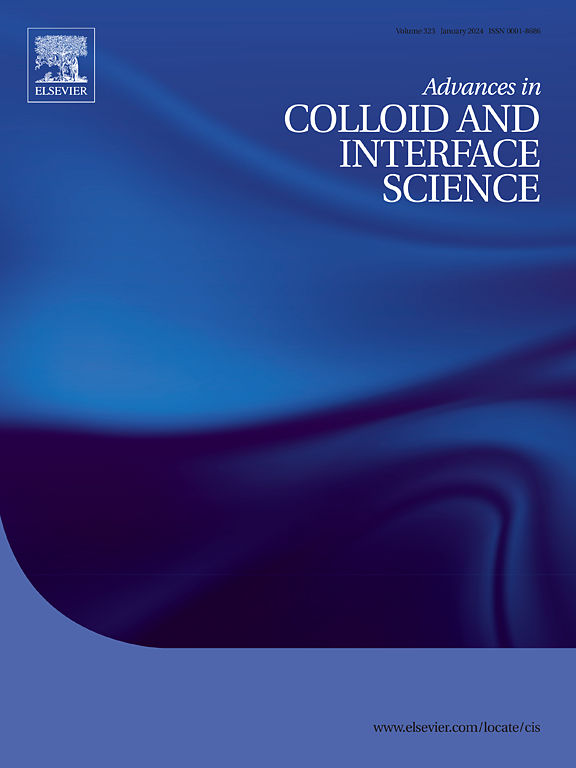“硅烷化”:用硅烷偶联剂进行表面改性
IF 19.3
1区 化学
Q1 CHEMISTRY, PHYSICAL
引用次数: 0
摘要
硅烷化是硅烷化的一种特殊变体,使用硅烷化合物,正在成为一种强大的材料表面功能化策略。与传统的硅烷偶联剂相比,硅烷具有显著的水解稳定性和更强的抗自缩聚能力,能够形成可控的、不依赖水的聚硅氧烷自组装单层。本文综述了硅氰基笼的独特结构,强调了分子内N->;Si键和螯合效应如何调节硅中心对羟基修饰表面的反应性。讨论了硅烷化和传统硅烷化在原料制备、沉积动力学和所得有机层形貌等方面的全面比较。系统地评估了关键反应参数——溶剂选择、温度、硅烷浓度和催化剂——以指导高效方案的设计。本文还概述了去除三乙醇胺副产物的策略,以实现无公害涂层。此外,分析技术(FT-IR, NMR, AFM, XPS)允许验证硅烷衍生自组装单层的正确形成。最后,综述展示了硅烷的广泛应用,强调了硅烷如何为金属氧化物、玻璃和有机聚合物提供耐用的功能界面。这里收集的见解旨在通过强大和通用的硅烷化方法加速表面科学和工程的未来创新。本文章由计算机程序翻译,如有差异,请以英文原文为准。

“Silatranization”: Surface modification with silatrane coupling agents
Silatranization, a specialized variant of silanization using silatrane compounds, is emerging as a powerful strategy to functionalize material surfaces. Compared to conventional silane coupling agents, silatranes exhibit remarkable hydrolytic stability and enhanced resistance to self-condensation, enabling controllable, water-independent formation of a polysiloxane self-assembled monolayer. This review critically examines the unique structure of silatranyl cages, emphasizing how the intramolecular N->Si bond and chelate effect modulate the silicon center's reactivity toward hydroxyl-decorated surfaces. The discussion encompasses a comprehensive comparison of silatranization and conventional silanization in the aspect of preparation of starting materials, deposition kinetics and morphology of resulting organic adlayer. Key reaction parameters – solvent choice, temperature, silatrane concentration and catalyst– are systematically evaluated to guide the design of efficient protocols. Strategies to remove triethanolamine byproduct are also outlined for achieving contaminant-free coatings. Additionally, analytical techniques (FT-IR, NMR, AFM, XPS) that allow to verify correct formation of a silatrane-derived self-assembled monolayer are presented. Finally, the review showcases wide-ranging applications underscoring how silatranes can provide durable, functional interfaces for metal oxides, glass and organic polymers. The insights collected here aim to accelerate future innovations in surface science and engineering through the robust and versatile approach of silatranization.
求助全文
通过发布文献求助,成功后即可免费获取论文全文。
去求助
来源期刊
CiteScore
28.50
自引率
2.60%
发文量
175
审稿时长
31 days
期刊介绍:
"Advances in Colloid and Interface Science" is an international journal that focuses on experimental and theoretical developments in interfacial and colloidal phenomena. The journal covers a wide range of disciplines including biology, chemistry, physics, and technology.
The journal accepts review articles on any topic within the scope of colloid and interface science. These articles should provide an in-depth analysis of the subject matter, offering a critical review of the current state of the field. The author's informed opinion on the topic should also be included. The manuscript should compare and contrast ideas found in the reviewed literature and address the limitations of these ideas.
Typically, the articles published in this journal are written by recognized experts in the field.

 求助内容:
求助内容: 应助结果提醒方式:
应助结果提醒方式:


